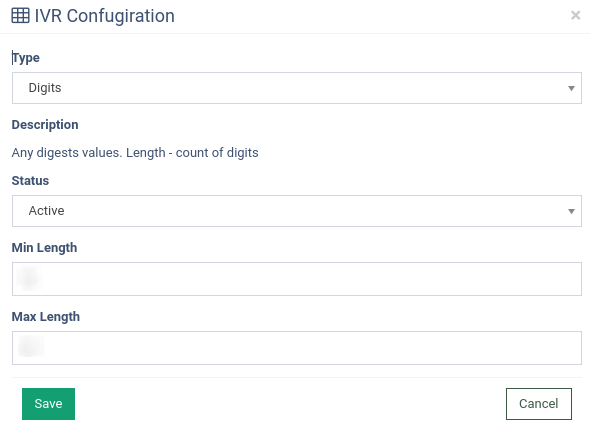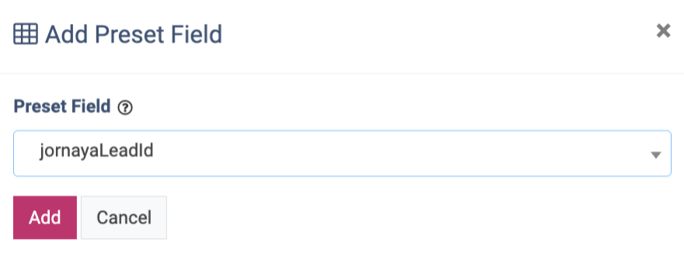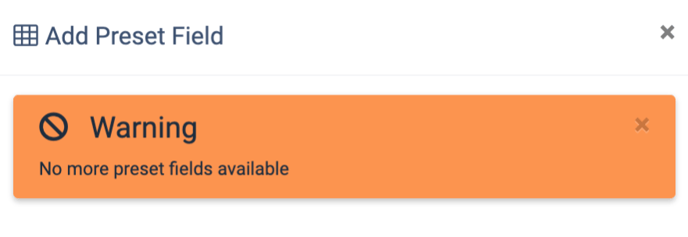The Extra Fields tab allows you to create and manage additional fields for the selected product.
To access the Extra Fields, go to the System Management > Products section, click the “Settings” button in the “Actions” column for the selected product, and select the “Extra Fields” tab.
-Oct-25-2024-09-01-48-2599-AM.png?width=688&height=260&name=unnamed%20(1)-Oct-25-2024-09-01-48-2599-AM.png) The “Extra Fields” tab contains the following information:
The “Extra Fields” tab contains the following information:
- Internal Name: The name of the field.
- Name In Reports: The name of the field that will be reflected in the reports and in the filter names.
- Field Protection: The type of the field protection to secure sensitive data sent in the field.
- Required: The status of the field requirement settings (Yes \ No)
- Description: Filter description.
- Format: The format example for the field.
- Example: The usage example for the field that will be displayed in the API documentation.
- Visible in API: Displaying the field in the API.
To add a field, click the “Add New Extra Field” button and fill in the following fields in the pop-up window:
-Oct-25-2024-09-03-00-9406-AM.png?width=491&height=672&name=unnamed%20(2)-Oct-25-2024-09-03-00-9406-AM.png)
- Type: Select the type of the field (New / Import).
Note: You can import a JSON file with one or multiple extra fields. - Internal Name: Enter the internal name of the field.
- Name In Reports: Enter the name of the field that will be reflected in the reports and the filter names.
- Validator: Select the type of field based on which data will be validated according to the set rules:
- String: The field type for the string data input. Fill in the “Min line length” and “Max line length” to determine the accepted string length.
- Array: The values validation will be based on the list of accepted values. Fill in the “Comma-separated list of valid arguments (ex.: option_1, option_2, option_3)” field to list all the values separated by commas.
- Date: The field type for the date input. The validator checks if the date is valid.
- Date in the future: The field type for the future date input only. The validator checks if the future date is valid. If the provided date is earlier than the next date, the lead can not be sold.
- Email: The field type for the email input.
- IP: The field type for the IP address input. Select the preferable option (IPv4 + IPv6 / IPv4 / IPv6) from the “Available IP Address Format” drop-down list.
- ZIP Code: The field type for the ZIP code input. Select the preferable option (ZIP Code / UK Post Code) from the “ZIP Code format” drop-down list.
- DOB: The date of birth input field. Select one of the available extra fields from the "Age field (DOB calculated)" drop-down list to record the calculated age according to the provided DOB value.
Note: The extra fields are available in the list only if they are not required and have an active status, the "Integer" field type, and the "Range" validator are selected. - Phone Number: The field type for the phone number input. Select the preferable option (Phone Number 7-13 digits / US Phone Number with Country Code / US Phone Number without Country Code / UK Phone Number with Country Code / UK Phone Number without Country Code) from the “Phone Number Format” drop-down list.
- State/Province: The field type for the State or Province input.
Advanced Settings
Click the “+Advanced Settings” button to set additional parameters to the new extra field:
Note: You can not make changes in preset fields except the “Is Required”, “Visible in API”, and “Description of API” settings.
- Field type: Select the field data type (String / Integer / Float number / Boolean / Json).
- Is required (Direct Post Products only): Define the field requirement settings.
- Select the “Force Required” option to make the field required.
- Select the “Not Required” option to make the field non-required.
- Ping Required (Ping-Post Products only): Define the field requirement settings on Ping.
- Select the “Force Required” option to make the field required.
- Select the “Not Required” option to make the field non-required.
- Post Required (Ping-Post Products only): Define the field requirement settings on Post.
- Select the “Force Required” option to make the field required.
- Select the “Not Required” option to make the field non-required.
- Encryption: Define the field encryption settings.
- Select the “Encrypted” option to encrypt the data in the field.
- Select the “No Encryption” option to leave the data unencrypted.
- Field Protection: The “Field Protection” settings allow you to protect your data from mass export. The fields are protected only within the detailed reports. Once you access a specific lead, field protection is not available. Select the preferable field protection option from the drop-down list to secure sensitive data sent in the field.
- Preparation: The “Preparation” settings allow you to prepare the received information for validation. Select the preferable way of data processing for this field from the drop-down list.
-
- Trim: The option removes the blank spaces from the received information. Example: “ trim ” > “trim”
- To digits: The option transforms the received information only into numerical data. Example: “12345abc” > “12345”.
- String to upper: The option converts received information into the upper-case letters. Example: “string” > “STRING”.
-
- YMD: The option converts received information into YMD format (year, month, date).
- Email: The option checks if the entered email is valid.
- Postcode: The option for the ZIP code input. The received information is converted into the postcode according to the selected area (US or UK).
- Canadian Postal Code: The option for the ZIP code input. The received information is converted into the postcode according to the Canadian area.
- Alias for Product Field: The option allows you to pull the value from another existing field of the Product for this exact field.
- Count non-empty fields (for LMS Products only): The option counts every non-empty field.
- Get city from zip: The option for the ZIP code input. The received information is converted into the City value assuming that no other value has been passed to this Extra Field.
- Get State from zip: The option for the ZIP code input. The received information is converted into the State value assuming that no other value has been passed to this Extra Field.
- Get zip from phone number: The option for the phone number input. The received information is converted into the ZIP value assuming that no other value has been passed to this Extra Field.
Filters
Note: Filters are applicable exclusively during the Post phase in Ping-Post Products.
Press the “+Add Filter” button and fill in the following fields to add a new filter option:
- Name: Enter the name of the filter.
- Type: Select the preferable filter type:
- Integer value: Allows you to assign the value properties.
- Select from list: Allows you to add a filter with the drop-down selection.
- Radio-buttons: Allows you to add a filter with the radio-button selection.
- Checkbox group: Allows you to add a filter with the checkbox selection.
- Starts with: Filters out the lead, if the field for which the filter is set starts with the specified input.
- Starts with one of: Filters out the lead, if the field for which the filter is set starts with one of the specified inputs.
- Does not start with one of: Filters out the lead, if the field for which the filter is set does not start with one of the specified inputs.
- Is empty: Filters out the lead, if the field for which the filter is set passes an empty value.
- Is non-empty: Filters out the lead, if the field for which the filter is set is not empty.
- Is empty (Ignore Ping): Filters out the lead, if the field for which the filter is set passes an empty value. This option ignores the ping (Ping-Post Products only).
- Is non-empty (Ignore Ping): Filters out the lead, if the field for which the filter is set is not empty. This option ignores the ping (Ping-Post Products only).
- Comma-separated numbers: Allows you to list the numerical data using commas.
- Comma-separated text: Allows you to list the data using commas.
- Integer value (min): Enter the minimum value length allowed for the filter.
- Integer value (max): Enter the maximum value length allowed for the filter.
- Is none of: Filters out the lead, if the field for which the filter is set does not start with one of the specified inputs.
- Description: Enter the filter description.
To edit the field properties, click the “Edit” button.
To remove the field, click the “Delete” button.
Please, note that you cannot create duplicates of existing parameters.
API Documentation Settings
Press the “API Documentation Settings” button and fill in the following fields to add the set of parameters to the API:
- Visible in API (optional): Select the preferable visibility option of the field in the API documentation (Not Visible / Visible). Note: The default configuration is set as “Visible”.
- Format for API: Add the format example for the field that will be displayed in the API documentation.
Examples: Numeric only, 10-11 digits long; One of the following: [YES, NO].
- Example for API: Add the usage example for the field that will be displayed in the API documentation. Description for API: Add the description of the field that will be displayed in the API documentation.
Click the “Create” button to confirm.
To edit the field properties, click the “Edit” button.
To remove the field, click the “Delete” button.
Please note that you cannot create duplicates of existing parameters.
To export the Product extra fields in JSON format, click the “Export” button. Select the extra fields you would like to export from the drop-down list in the pop-up window.
-Oct-25-2024-09-14-34-6551-AM.png?width=493&height=185&name=unnamed%20(3)-Oct-25-2024-09-14-34-6551-AM.png)
Click the “Export” button to proceed.
Note: This feature can help you import the corresponding extra fields to other Products in your system.
Preset Fields
To add special service fields (Trusted Form URL, Jornaya Lead ID, I Claim Session Id) as extra fields for the Product, click the “Add Preset Field” button. Make a selection in the “Preset Field” pop-up window and click the “Add” button.
Please, note that preset fields are available only for custom products. Once the preset fields are added, they can not be edited or deleted. In case all available preset fields are added, the "No more preset fields available" pop-up window will be displayed.
Extra Fields in IVR
To configure the Extra Field to be used in IVR, go to the System Management > Products section, click the “Settings” button in the “Actions” column for the selected product, and select the “Extra Fields” tab.

Click the “IVR Configuration” button in the “Actions” column for the selected Product Extra Field to configure and use it in IVR.
Select one of the following IVR extra fields types from the “Type” drop-down menu:
-
Range:
-
Digits: Set the minimum and the maximum number of characters accepted in this field (1 to 15). For example, this type can be used for the Year of Birth field or Vehicle Manufacturing Year field.
-
-
Fixed:
-
Short SSN: Can be used for the 4-digit SSN field. All settings are predefined.
-
ZIP Code: Can be used for the ZIP code field. All settings are predefined.
-
-
Date:
-
Day: Select a day in a month (1-31). All settings are predefined.
-
Full Date: Select a date in MMDDYYYY format (month, day, year). All settings are predefined.
-
Month: Month number (1-12). All settings are predefined.
-
My date: Select a date in the MMYYYY format (month, year). All settings are predefined.
-
Year: Select four digits for the year (from 1923). All settings are predefined.
-
-
Selector:
-
Custom: Create custom options (press 0-9). At least two options should be created. For example, it can be used for Insurance types (1 - Auto, 2 - Life).
-
Gender: The Gender predefined selector (1 - Male, 2 - Female).
-
Score: The Credit Score predefined selector (1 - Excellent, 2 - Good, 3 - Fair, 4 - Poor).
-
Yes/No: The Yes/No predefined selector (1 - Yes, 2 - No).
-
-
Status: Set the status defining if this field will be available in IVR (Active, Disabled).

Find the list of IVR blocks in which Extra Fields can be used in this Knowledge Base article.


